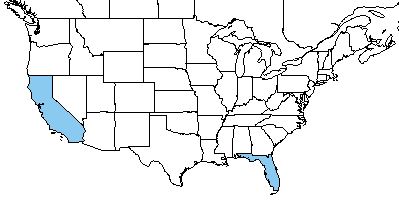Difference between revisions of "Ipomoea triloba"
Emmazeitler (talk | contribs) |
Emmazeitler (talk | contribs) |
||
| Line 34: | Line 34: | ||
===Habitat=== <!--Natural communities, human disturbed habitats, topography, hydrology, soils, light, fire regime requirements for removal of competition, etc.--> | ===Habitat=== <!--Natural communities, human disturbed habitats, topography, hydrology, soils, light, fire regime requirements for removal of competition, etc.--> | ||
| − | This species can be found in | + | This species can be found in hammocks, sand dunes, disturbed areas<ref name="Weakley> Weakley, A. S. (2015). Flora of the Southern and Mid-Atlantic States. Chapel Hill, NC, University of North Carolina Herbarium. </ref> especially roadside ditches as well as gardens and planted shrubbery.<ref name="Herbarium"> Florida State University Robert K. Godfrey Herbarium database. URL: http://herbarium.bio.fsu.edu. Last accessed: May 2018. Collectors: Travis MacClendon, Loran C. Anderson, Robert K. Godfrey, Floyd Griffith, Geo Wilder, Boothes, Andre F. Clewell, R. Komarek, J. M. Kane, John B. Nelson, and Pat Ferral. States and Counties: Florida: Calhoun, Franklin, Gadsden, Holmes, Jackson, Jefferson, Leon, Liberty, Wakulla, and Washington. Georgia: Thomas. South Carolina: Georgetown. </ref> It has been found in dry to moist loamy and sandy soil.<ref name="Herbarium"/> |
Associated Species - ''Cyperus erythrorhizos'', ''Panicum dichotomiflorum'', ''Bidens bipinnata'' and ''Fatoua villosa'', Carex, Polypogon, Verbena, '' I. cordatotriloba'',''Eupatorium capillifolium'', ''Pluchea camphorata'', ''Rhynchospora corniculata'', and ''Panicum verrucosum''.<ref name="Herbarium"/> | Associated Species - ''Cyperus erythrorhizos'', ''Panicum dichotomiflorum'', ''Bidens bipinnata'' and ''Fatoua villosa'', Carex, Polypogon, Verbena, '' I. cordatotriloba'',''Eupatorium capillifolium'', ''Pluchea camphorata'', ''Rhynchospora corniculata'', and ''Panicum verrucosum''.<ref name="Herbarium"/> | ||
Revision as of 11:29, 17 September 2020
Common name: Little-bell[1]
| Ipomoea triloba | |
|---|---|

| |
| Photo by John B | |
| Scientific classification | |
| Kingdom: | Plantae |
| Division: | Magnoliophyta - Flowering plants |
| Class: | Magnoliopsida - Dicots |
| Order: | Solanales |
| Family: | Convolvulaceae |
| Genus: | Ipomoea |
| Species: | I. triloba |
| Binomial name | |
| Ipomoea triloba L. | |

| |
| Natural range of Ipomoea triloba from USDA NRCS Plants Database. | |
Contents
Taxonomic Notes
Synonyms: none.[1]
Varieties: none.[1]
Description
I. triloba is a perennial forb or vine. It belongs to the Covolvulaceae family. This species is not native to the continental United States.[2]
Distribution
I. triloba is not native to the continental United States, and it has been introduced to California and Florida.[2] It is found throughout the West Indies, New World tropics, and Old World tropics.[1]
Ecology
Habitat
This species can be found in hammocks, sand dunes, disturbed areas[3] especially roadside ditches as well as gardens and planted shrubbery.[4] It has been found in dry to moist loamy and sandy soil.[4]
Associated Species - Cyperus erythrorhizos, Panicum dichotomiflorum, Bidens bipinnata and Fatoua villosa, Carex, Polypogon, Verbena, I. cordatotriloba,Eupatorium capillifolium, Pluchea camphorata, Rhynchospora corniculata, and Panicum verrucosum.[4]
Phenology
I. triloba flowers from late August into early November.[4]
Conservation and Management
This species is considered a Restricted Noxious Weed in Arizona and a Noxious Weed in Florida and Arkansas. It is considered a Plant Pest in South Carolina and a U.S. weed.[2]
Cultivation and restoration
Photo Gallery
References and notes
- ↑ 1.0 1.1 1.2 1.3 Weakley, A.S. 2015. Flora of the southern and mid-atlantic states. Working Draft of 21 May 2015. University of North Carolina at Chapel Hill, Chapel Hill, North Carolina.
- ↑ 2.0 2.1 2.2 USDA Plants Database URL: https://plants.usda.gov/core/profile?symbol=IPTR2
- ↑ Weakley, A. S. (2015). Flora of the Southern and Mid-Atlantic States. Chapel Hill, NC, University of North Carolina Herbarium.
- ↑ 4.0 4.1 4.2 4.3 Florida State University Robert K. Godfrey Herbarium database. URL: http://herbarium.bio.fsu.edu. Last accessed: May 2018. Collectors: Travis MacClendon, Loran C. Anderson, Robert K. Godfrey, Floyd Griffith, Geo Wilder, Boothes, Andre F. Clewell, R. Komarek, J. M. Kane, John B. Nelson, and Pat Ferral. States and Counties: Florida: Calhoun, Franklin, Gadsden, Holmes, Jackson, Jefferson, Leon, Liberty, Wakulla, and Washington. Georgia: Thomas. South Carolina: Georgetown.